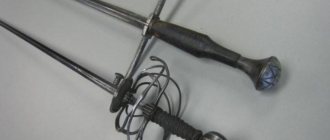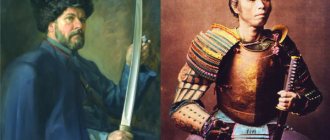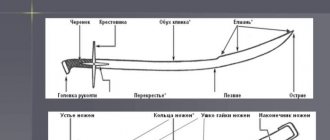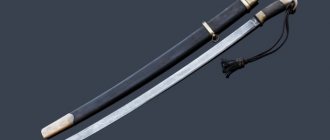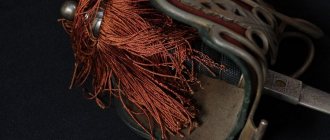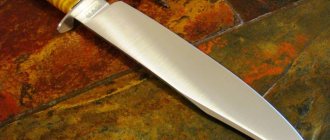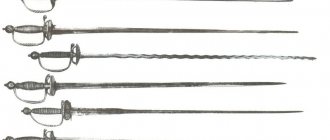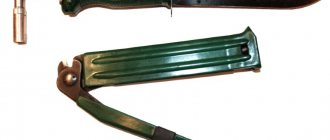Someone will come out of the fog, take something out of his pocket, and only the ataman’s eye will immediately see who and what. He blows without deception: In the shuyts there is a sharp katana (Something like a scimitar), And in the right hand there is a chisel.
(Russian folk song)
A man's worth is not determined by the length of his sword.
© Miyamoto Musashi
(Photo: David Benzal)
I’ll say right away: firstly, I believe that a katana is a sword. Secondly, it doesn't matter.
Let's start from the opposite point of view: “a katana is a saber.”
This position is based on the appearance of the object, exists in the nutrient medium of social networks and has its own specific population of carriers.
The latter are poorly familiar with Japanese culture, as well as with the military affairs of medieval Europe. They believe that it is enough to classify weapons only by the shape of the blade, more precisely by its bend. Therefore, a long-bladed weapon with a curved single-edged blade and any handle is called a saber. A sword is one with a straight, double-edged blade and a guard in the form of a cross. Everything that does not fall into these descriptions has its own unique names: broadsword, rapier, colishemar, falchion, cleaver, sword, saber.
In the popular mind, a sword is always a connotation of high status, chivalry and culture, a symbol of heavenly romantic power. And a crooked saber is, they say, a vile Asian piece of iron that does not chop at all, but only cuts.
Zamecki
Now the Poles were offended. I, Mr. Zametsky, am inflated with pride for my saber.
What does the sword mean?
The SWORD is one of the most complex and most common symbols. ... The sword is also a powerful magical symbol, an emblem of witchcraft. In addition, the sword is a symbol of power, justice, supreme justice, all-pervading intelligence, insight, phallic power, light, division and death.
Interesting materials:
What part of the hydrosphere is occupied by water that is underground? What part of all the waters on the planet is the World Ocean? What container of water can be placed in the oven? What mineral water should I use for barbecue? What role did water play in the origin of life on Earth? What water should I use for a saltwater aquarium? What kind of water do barbs like? What kind of water do daisies like? What kind of water should be poured into the water filter? What kind of water should I pour into the Aquaphor filter?
Saber
What is the main difference between a saber and a sword? A sword is a bladed weapon, in most cases with a long, straight, double-edged blade. The saber has a curved blade, mainly with one-sided sharpening. This blade shape is lighter and therefore strikes faster.
The classification of bladed weapons is so complex and confusing that many researchers, for example, successfully define a katana as both a sword and a saber. Despite the common name “samurai sword,” the katana should still be classified as a saber. The coincidence of the main qualitative characteristics and the insufficient number of significant differences are obvious. This allows us to distinguish the katana into a separate type of bladed weapon. Also, despite the downward curved blades, scimitars should also be classified as sabers.
But the weight and curve of the blade are not the only differences between a sword and a saber. The fundamental differences lie somewhat deeper. The development of the sword followed the path of making fencing easier: the center of gravity was shifted to the hilt, which contributed to a greater depth of penetration during a piercing blow. This trend was due to the widespread use of heavy armor that completely covered both the warrior and his horse. They were almost impossible to cut, but they could be pierced through the joints. This allows us to consider the sword the progenitor of the sword, rapier and broadsword. In addition, the warrior, clad in solid armor, was limited in his movements. This made it difficult to perform sweeping cutting blows characteristic of a saber.
The development of the saber followed the path of reducing the effort to deliver a chopping blow, covering a large area. This was achieved by reducing the weight of the weapon, moving the center of gravity closer to the tip and tilting the handle towards the blade.
Thus, the eternal debate “which is better” will remain unresolved. The sword was relevant in Western and Central Europe, where massive armor was widely used. The saber was better suited for fighting against a weakly protected enemy. On the one hand, 20 heavy knights had superiority against 100 light horsemen. On the other hand, with the advent of small arms, armor, and with it the sword, became a thing of the past, while the saber continued its glorious path.
Considering the wide distribution area of this type of bladed bladed weapon, it is almost impossible to trace any general trends in the development of thousands of different samples. It is known that the first models, weapons of noble warriors, were, as a rule, richly decorated. After the saber became a weapon of the “broad masses”, it headed for simplicity and low cost of production. This does not apply to the famous sabers made of Damascus steel, the price of which has not decreased due to the complexity of production and the large waste of metal, as well as to the best sabers made of damask steel.
The main difference between the sabers of the Far East and Europe can be considered the guard. On European models, a metal cross was fixed in front between the shoulders of the blade and the handle, providing protection for the hand. Over time, it evolved into complex closed structures. In the Far East, the guard was not a cross, but a round or oval tsuba of simple design. Also, fairly simple European blades did not have a strong bend in comparison with Asian samples.
At the turn of the XIII-XIV centuries. The design of sabers is changing significantly, which allows these weapons to almost completely displace swords from the armament of the armies of different countries. First of all, blades with elmanya appeared - a thickening on the blade (the upper third of the blade), moving the center of gravity of the blade away from the hilt. This increased the inertia of the saber's chopping blow. In addition, the bayonet-shaped point of the saber, which came into use in many Asian countries, could easily pierce the rings of chain mail.
The saber itself appeared around the 6th-7th centuries. among the Turkic peoples. The history of its origin is quite complex and does not give clear answers. Maybe this happened as a result of the natural evolution of edged weapons with a curved blade. This form for blades made of bronze and copper was considered the best, because it made it possible to obtain a weapon of the required length with low weight. Perhaps this is a well-thought-out type of sword with a straight blade, which has reduced weight and improved chopping properties with less effort. It's hard to say now. It is known for sure that in the 7th century. From Altai, the saber came to the Khazar Kaganate and became widespread among the nomadic peoples of Eastern Europe.
Mongol saber
It is not known exactly how and when the saber appeared among the Mongols. There is an opinion that it was used by pre-Mongol tribes since the Northern Wei dynasty. Although there is no evidence of this point of view at the moment. The first documentary mention of the use of salems (“sabers” in Mongolian) along with swords and broadswords dates back to the time of the Mongols’ conquest of the Turkic peoples.
The Mongol-Tatar invasion forced other peoples to reconsider their attitude towards the saber. Under the influence of conquered peoples and the constantly changing nature of warfare, the saber has changed significantly.
Saber in Eastern Europe
Around the 9th-11th centuries. The saber came to Rus' with nomadic peoples. Due to the rapid development of cavalry during this period, it quickly became widespread all the way to Minsk, Novgorod and Suzdal Opolye. In the northern regions of Rus', where the influence of cavalry was not yet so strong, a sword was more often used, which was more suitable for the requirements of a foot warrior. However, the situation changed dramatically with the onset of the Tatar-Mongol hordes.
A new stage in the development of this type of weapon in Eastern Europe began in the 15th century, when the saber became the main weapon of many cavalry formations of united Rus', Ukraine, as well as Poland and Hungary. They, unlike their western neighbors, constantly had to face lightly defended opponents from the east. The saber was much more effective against them than the sword.
The use of the saber in the armies of Poland and Hungary is closely connected with the name of the Polish king of Hungarian origin, Stefan Batory (reigned 1576-1586). He contributed to the recognition of Hungarian-type sabers in Poland. Over time, this led to the emergence of a national Polish saber called “karabela”.
As for the Hungarian sabers, they had a great influence on the development of not only Polish weapons (also Zaporozhye and Russian), but also the countries of Central Europe. This is due to the rapid development since the beginning of the 17th century. own production of this type of weapon, still unfamiliar to Europe, as well as with the evolution of Polish and Hungarian hussar formations, which showed themselves in internal European wars. One of the clearest examples of such influence is the use by the Austrians of the heavy cavalry saber of the Hungarian Madonna type, which was considered the patroness of the Hungarians. Its distinctive feature was the engraving of the Madonna's face on the wide blade.
Since the 18th century in Eastern Europe, the saber comes into service with light cavalry, as well as officers of all branches of the military. The Russian Empire gradually switched from sabers of the Polish-Hungarian type to samples that came to its territory from the Caucasus, which led to the adoption of sabers. From that time to this day, the saber has been a ceremonial weapon.
Saber in the near world
Despite the almost simultaneous appearance of the saber in Rus' and in Arab countries, it remained for a long time in the shadow of weapons with a straight blade. Only from the middle of the 12th century. The military minds of Iran, Egypt and the Caucasus countries turned their attention to the saber. As in Rus', the Mongol invasion became a powerful impetus for the spread of weapons with a curved blade. By the middle of the 13th century. The saber quickly replaced swords and broadswords in this region. And already from the end of the 15th - beginning of the 16th centuries. saber production in the Arab world reached such a high level of development that it began to influence Eastern Europe, where imported “eastern” sabers became widespread.
The great popularity of the saber in the Islamic world leads to the appearance of numerous local examples. First of all, this is shamshir, which has become famous in the territory from Morocco to Pakistan. The narrow, long and highly curved blade was often engraved with sayings from the Koran. High-quality blades were made from Damascus steel. Due to the strong curvature of the blade, the shamshir is classified as a chopping weapon.
The next type of saber, kilic, or klych, was highly valued by the Mongol-Tatar hordes, Russian principalities and Cossacks. But Türkiye became the main center of its development. Sabers became widespread among the Turkic-Persian Seljuk dynasty
On the flag of the Kingdom of Saudi Arabia, the shahada (the first of the five pillars of Islam) is located above the scimitar (design 1938-1973, in the modern version the scimitar is stylized). Sometimes the name “scimitar” was applied as a collective name to all Asian sabers back in the 9th-10th centuries, however, the Turkish kilic acquired its characteristic features only by the 16th century.
Arab children armed with scimitars. Postav Boulanger, "The Tale of 1001 Nights", 1873
Kilich was used equally successfully by both foot soldiers and horsemen. Since the end of the 19th century. Turkish theorists decided to reorganize the army, taking the leading armies of Europe as an example. After this, the kilic went out of widespread use, although later there were sabers that imitated it in their shape.
Kilic - a weapon for both foot soldiers and horsemen
Saber in Central and Western Europe and the USA
Once in Europe, the saber was initially met with disdain. First of all, this was due to the fact that it was practically useless against heavy armor, widespread in Central and Western Europe. In addition, the knightly class, faithful to the sacred sword, considered the saber a weapon of the semi-wild poor and robbers of the East. A few examples of the use of a saber are the two-handed gross messer, which became the prototype for the cleaver, and a large number of massive short sabers (cortelas, malkus, storta, etc.), invisible under the shadow of the leading weapon of Europe of this period - the sword.
From about the middle of the 17th century. even ardent opponents of the saber had to admit the need to use this weapon in the ongoing struggle with the eastern armies. In the wars against Turkey, during the Egyptian campaign (an attempt to conquer Egypt in 1798-1801) by Napoleon, it became clear that against a weakly protected enemy the power of the sword was inferior to the functionality of the saber. The Mamluk saber (Mameluk) - a strongly curved (up to 45°) Turkish saber, which was in service with the Mamluk detachments - very quickly gained respect among the light cavalry officers of France and Britain.
After defeating the rebels holding the fortress at Tripoli during the First Barbary War, senior Marine officers were awarded jewel-encrusted sabers. To this day, sabers similar to the Mamluk are an element of the uniform of US Marine Corps officers
From the beginning of the 19th century. The saber began to be actively used in internal European wars. For example, the British government, after declaring war on France on May 22, 1803, officially approved the use of sabers by infantry officers. Since 1831, the Mamluk became part of the equipment of the high command of Her Majesty's troops. In many European armies, the saber was in service until World War II, and the Belgian gendarmerie used the saber until 1950.
Saber in Dadnedo East
The first graphic depiction of a saber-like weapon from the Far East is found in China on reliefs from the Han Dynasty (206 BC - 220 AD). However, it does not appear to have gained widespread acceptance. The first sabers that came into use date back to the reign of the Northern Wei dynasty (386-534). Around the same time, these weapons also entered Korea, as evidenced by a fresco from a Goguryeo tomb in Yaksuri (5th century), and then to Japan.


